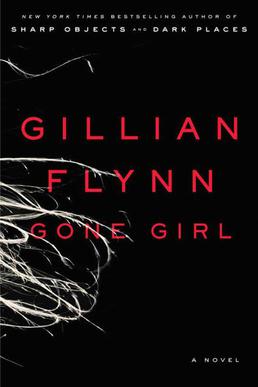What We’re Reading (Summer 2014): Gone Girl
 In this series of summer posts, MG staffer Kelly Nhan will be exploring books and music, festivals and goings-on, anything and everything Midwestern-related, and reporting her findings.
In this series of summer posts, MG staffer Kelly Nhan will be exploring books and music, festivals and goings-on, anything and everything Midwestern-related, and reporting her findings.
**
Gone Girl, by Gillian Flynn
(Warning: major spoilers ahead)
Gone Girl is one-part psychological thriller, and two-parts marital drama. The basic premise of Gillian Flynn’s bestseller and soon to be released film, is, at first, a familiar one: Amy Dunne is the pretty, blonde missing wife to Nick Dunne’s husband looking for answers. The Dunnes, both laid off from their writing jobs during the recession, relocate from their native Manhattan to care for Nick’s aging parents in Carthage, Missouri. The action unfolds through alternating narratives (a “he-said, she-said” fleshed out to novelistic proportions): Nick’s portions move forward from the day he returns home on the morning of their fifth anniversary to find a missing Amy and the ominous signs of a struggle while Amy’s fill in the gaps via diary entries dated back to the party where they first met moving forward to where Nick’s begins. Flynn layers the growing tension skillfully, dropping unsettling details within both narratives that sprout into questions and then bloom into full suspicion. An example: Why does Nick keep picturing a bleeding Amy on the floor of their living room?
 Flynn takes the device of the unreliable narrator to its furthest ends in Gone Girl; Nick (in the first half) and Amy (in the second half) break through the confines of the narrative and directly address the reader to chilling effect. Nick’s dealings with the lead investigators in his wife’s case are peppered throughout with seemingly senseless white lies, which come to a head when he mentions off-hand, “I’m a big fan of the lie of omission.” Our suspicions are addressed head-on and without qualm. Gone Girl succeeds because it at first seems to build to climax according to the crime thriller formula and then goes onto flip that formula on its head halfway through the novel—Again, spoiler alert—when it is revealed that Amy is alive and in hiding, that the Amy we have come to know (and love) is merely a character within the real Amy’s fabricated diary written to frame her husband through a series of elaborate and at times unbelievable schemes.
Flynn takes the device of the unreliable narrator to its furthest ends in Gone Girl; Nick (in the first half) and Amy (in the second half) break through the confines of the narrative and directly address the reader to chilling effect. Nick’s dealings with the lead investigators in his wife’s case are peppered throughout with seemingly senseless white lies, which come to a head when he mentions off-hand, “I’m a big fan of the lie of omission.” Our suspicions are addressed head-on and without qualm. Gone Girl succeeds because it at first seems to build to climax according to the crime thriller formula and then goes onto flip that formula on its head halfway through the novel—Again, spoiler alert—when it is revealed that Amy is alive and in hiding, that the Amy we have come to know (and love) is merely a character within the real Amy’s fabricated diary written to frame her husband through a series of elaborate and at times unbelievable schemes.
The real Amy is, in fact, a highly manipulative, calculating, and vengeful sociopath who has vowed to “punish” her husband for his infidelity, another piece of dirty laundry revealed post-hoc. It is after this revelation where Gone Girl falls into troubled waters. The switch in Amy is severe, her compulsions and master-mining verging on super villain. The creation of the “likable victim”—that is, diary Amy—is tremendously convincing, the “real Amy” is almost cartoonish in preening narcissism and almost limitless taste for revenge. Ultimately, Amy fits comfortably into the stereotype of the castrating, overbearing post-feminist wife. Even more troubling are the details of Amy’s manipulations, past and present: she uses a pregnancy to keep Nick in the marriage, makes a fake sexual assault allegation, and fashions a former boyfriend into a stalker all in the service of her personal vendetta and need for validation. Gillian Flynn, in response to critics pointing out the novel’s embedded misogyny, writes on her website as noted in an article on the subject in the UK’s The Guardian,
“Isn’t it time to acknowledge the ugly side? I’ve grown quite weary of the spunky heroines, brave rape victims, soul-searching fashionistas that stock so many books. I particularly mourn the lack of female villains—good, potent female villains. Not ill-tempered women who scheme about landing good men and better shoes (as if we had nothing more interesting to war over), not chilly WASP mothers (emotionally distant isn’t necessarily evil), not soapy vixens (merely bitchy doesn’t qualify either). I’m talking violent, wicked women. Scary women. Don’t tell me you don’t know some. The point is, women have spent so many years girl-powering ourselves—to the point of almost parodic encouragement—we’ve left no room to acknowledge our dark side.”
Unfortunately, Amy becomes yet another stock character within the contemporary imagination of feminist nightmares: the “psycho bitch”, as Nick Dunne puts it. The characters, as Gone Girl progresses, begin to fulfill the gendered tropes that Flynn seeks to subvert. They fill those stock roles in more complicated and ironic ways, for sure, but fill them nevertheless. Nick, by the end of Gone Girl, if not a previously abusive husband, now envisions actually killing his wife. Diary Amy is revealed to be the manipulative bitch, who caves when flattered by her philandering husband.
The relationship between these two certainly troubled characters, which lies at the heart of the novel, is framed within the expectations of genre, and more basically, of what makes a “good” story. At its best, Gone Girl explores the complicated give-and-take of relationships, and how character (or alternately, persona) are formed through storytelling in a kind of meta-narrative mode as we see Nick build up a defense as public sentiment starts to turn on him. Gone Girl is ambitious and undeniably seductive in its ability to “play” its readers like the best of thrillers do. Its subversive potential, however, is another story.
Shop for Gone Girl: A Novel
, by Gillian Flynn
**

 Kelly Nhan is a senior studying English and Women’s Studies at the University of Michigan, and originally from Connecticut. She loves finding good coffee places, exploring cities, reading good poetry, and chatting about feminism. She is interested in going into book publishing, or eventually going to grad school to study post-colonial literature and feminist theory.
Kelly Nhan is a senior studying English and Women’s Studies at the University of Michigan, and originally from Connecticut. She loves finding good coffee places, exploring cities, reading good poetry, and chatting about feminism. She is interested in going into book publishing, or eventually going to grad school to study post-colonial literature and feminist theory.







July 24th, 2014 at 4:45 pm
Gone Girl is a dark comedy, the plot follows the well-known process of so many relationships…